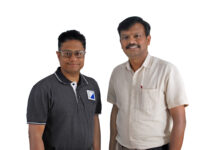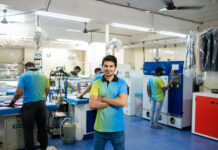Healthcare costs are rising all over the world. The present consumer demands innovative and new techniques of healthcare services as per their lifestyle. To utilize these healthcare services, the system demands the patient be physically available at the doctor’s location. Whereas, research indicates that in 3 out of every 4 in-patient visits to primary care physicians, emergency care – could be handled remotely via phone or video.Connect2MyDoctor provides a comprehensive virtual platform to complement how people access and experience healthcare worldwide. Startup Reporter recently conducted an interaction with Mr. Pramod Kutty, CEO & Co-Founder, Connect2MyDoctor.
What is Connect2MyDoctor?
Connect2MyDoctor enables healthcare providers to unleash the power of Digital Health. We are democratizing the healthcare experience and providing healthcare providers with tools and capabilities in providing better health outcomes. We work with some of the leading multi and super-specialty hospitals across the Asia Pacific and the Middle East. Since our launch in 2016, we have helped patients from over 15+ countries access specialists through private and secure virtual consultations. Headquartered in Melbourne the company has a local office in India and Dubai.
Can you elaborate on the company’s goals and objectives?
Our vision is to enable people to Manage their Health Better. Everything that we do today is towards this vision. We started addressing the problem of accessibility by connecting patients and doctors through a virtual care platform. As we moved forward, we are building tools that will assist doctors to provide an enriched experience in understanding health problems using
- OmniROM – our tele-rehabilitation tool for patient recovery;
- cARe – our 3D and AR platform to educate their patients;
- HomeDoc – our home care module with device connectivity
With these initiatives, we are gearing to expand geographically while staying focused on our goals of better patient health
As the CEO and Co-founder of Connect2MyDoctor, how did you come up with the idea of telemedicine? Could you give us a brief backstory?
I moved to Australia after spending a long career in UAE and India where specialist care was easily accessible. The healthcare system in Australia is different where access to care is through referrals and the wait periods are long. During my early days, I had the experience of having to wait for 3 months for a specialist appointment for my daughter. During this waiting period, we got some advice from doctors in the family and also read a lot of misleading information from Dr. Google/ Dr. Internet. As I had a background in product and business management, I felt that there is something missing and that the gap needed to be filled. We validated this with some primary research with patients and doctors and realized that there is a gap to be filled which led to the start of Connect2MyDoctor. There has been no looking back since then.
How can a rural person benefit from online healthcare?
People from rural areas often do not have easy access to healthcare. Online healthcare negates this disadvantage. Patients are able to consult with expert physicians online by booking an appointment. We are looking to add to the facilities available by offering better, more updated virtual healthcare.
There are many instances where the platform has assisted patients in rural areas who have got care from Doctors in the city but the one that stands out is a family from Kolkata who has been a regular user of the platform to consult their Endocrinologist since 2016. The closest doctor and lab facility to them is around 350km away.
What were the main obstacles you faced while launching the telemedicine platform and mention how you overcame them?
Network Speeds – In 2016, the internet speeds were 1Mbps and the era of the 3G network. It was very difficult to have the video streaming on the platform for consultations outside the Tier 1 cities. This challenge led us to optimize the platform and video streaming based on the network speeds and ensure that it was functioning well at low speeds as well.
Patient trust and knowledge of Telemedicine – Until very recently patients were not very familiar with the idea of using mobile apps to book appointments, make payments via credit/debit cards, and see the doctor of choice on a tiny screen. We overcame this challenge by running patient education programs using print and digital media, hand-holding a couple of times during the appointment, etc. COVID-19 changed all this along with the advent of smarter phones and big screens.
Previous bad experiences for doctors – While telemedicine has been around for many years, there were a lot of false attempts during the time we launched the platform. This led to doctors losing faith in technology providing care via a screen. But we also had some dynamic doctors who were ready to try new things. While they started using the platform, we used them as influencers to encourage doctors to try the technology. In addition, we also made the platform very simple and straightforward which has been one of our successes.
During the pandemic, there was faster adoption of Online Healthcare in India, how did C2MD help in this?
The COVID-19 pandemic made remote healthcare solutions go from a niche rarity to a preferred mode of care. Globally, there has been a huge adoption of digital health among both providers and patients. While the technology has been around for many years, the lockdowns drove them to experience it firsthand and then embrace it for the future.
We are happy to note that C2MD has been able to play a critical role in uplifting online healthcare in India and certain other countries. Patients now trust the online process and are ready to gain from the advantages offered by virtual healthcare.
What are the innovative tools of C2MD and what are its unique features?
To start with, cARe, Connect2MyDoctor’s 3D and AR module, launched recently, can be used for patient education during in-person and tele consultations, continuing professional development (CPDs), virtual tumour boards (VTB), medical colleges, etc.
Using 3D and AR in tele rehabilitation can be another game changer. The global industry average completion rate for physiotherapy sessions is less than 30%. Using technology, patients are now able to measure the Range of Motion (ROM) from the comfort of their homes, view progress, connect with the Physiotherapists (PT) remotely and share data regularly, etc. The PTs are able to share videos of the exercise routines that the patients can use during their daily sessions.
Can you clear the cost myths around tech adoption in hospitals?
A closer understanding of the concept will reveal that it is quite economical especially when one achieves economies of scale. In our cARe module, the models and figures that are developed as part of the platform can be reused across locations, outpatient, and online consultations. The models and figures can also be customized as per the requirement of the specialized doctor/specialty. They are shared assets that can be used across the departments. This can also be deployed at satellite centers and also at PHCs where the outpatients can be completely educated before they travel to specialty centers for the procedures.
How technology interventions are playing a major role in medical education? Also, brief us about the significance of using tech tools in patient education.
3D/AR technologies can amplify the practical learning process, especially for young medicos as they get ready for the real world of medical practice. cARe, the 3D/AR tool that we have launched on Connect2MyDoctor, will reduce/eliminate the need for real patient bodies to learn. 3D/AR technologies can help in understanding complex surgical processes and for a clearer understanding of human anatomy. This also gives them the ability for continuous, repetitive learning in real-life experiences with low risk and affordability.
Imagine a scenario where a patient from Oman coming to India for treatment is clearly aware of what the medical procedure is going to be. Our 3D/AR module -cARe, can help patients understand in detail the procedure beforehand. 3D/AR-based modules can give hospitals an edge in patient experience.
What is the Future of digital health, its possibilities, and its benefits in India?
Today, Healthcare Personnel have started thinking beyond standard video consultation, which is considered basic and given. The next steps will involve using AR for patient education, continuous care, collecting data from medical devices, remote monitoring, and smart alerts from qualified nurses, being part of virtual tumour boards, care from the bedside, connectivity from the nearest PHC than long-distance travel, speech to text for adding information into the prescription and clinical notes. Without a doubt, the next 10 years of telemedicine will be far ahead of the previous 10 years.
How are you planning to grow Connect2MyDoctor as a company worldwide?
Today we work with hospitals across Asia and the MEA region. In the coming days, we will be adding more tech tools in Visual AI, Home, and Integration with Speech to Text which will provide great value to our partners. With these features, we aim to work with 70-80% of the top hospitals in the regions we operate and also give us an edge to enter new markets. The idea is not breadth but depth in each engagement enabling us to solidify the relationship which we have seen to be working for us.
Visit https://www.connect2mydoctor.com/
Views: 1



